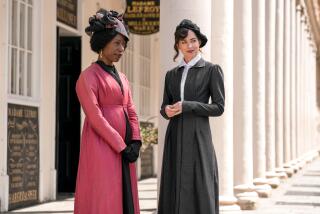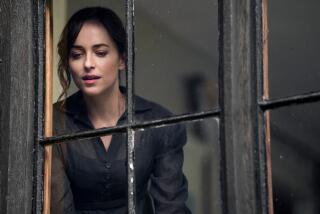BOOK REVIEW : A Jane Austen Classic Revisited : JANE FAIRFAX <i> by Joan Aiken</i> ; St. Martin’s Press $17.95, 252 pages
Extending the classics, a trend that may have begun with the Apocrypha but that has been gathering momentum ever since, continues with “Jane Fairfax,” a bravura attempt to enlarge upon Jane Austen’s beloved novel “Emma.”
Having enjoyed considerable success with her prior incursion into Austen territory, “Mansfield Revisited,” Joan Aiken returns to Highbury, the tiny rural village where Emma and Jane grow up as friends and rivals.
As Austen’s admirers know, Emma Woodhouse is the privileged one, indulged by her invalid father. She entertains herself by engineering the romances of clever Jane Fairfax and silly Harriet Smith. Frivolous but endearing, Emma Woodhouse is one of Austen’s most felicitous creations; the witty dialogue and delicate machinations of the plot masking tart social commentary.
Rewriting Austen, however, may be a more difficult matter than bringing Sherlock Holmes out of retirement or examining Jekyll and Hyde from the housekeeper’s point of view. Austen was an inimitable stylist whose elegantly convoluted sentences reflected the natural speech of the gentry in the early years of the 19th Century.
Form was quintessential; manners were elaborate and formal. Codes of speech were as strict as codes of behavior, and half the delight in reading Austen is in solving the emotional riddles concealed in the exquisitely polite language. Writing a 19th-Century novel of manners today poses the same challenges as writing a grand opera. The result, even in the most skilled hands, can sound strained and artificial at best a tour de force, often a pedantic exercise in an alien mode, sometimes merely quaint.
Still, those who regularly reread “Emma” as an antidote to the 11 o’clock news may find that “Jane Fairfax” offers some similar therapy. We’re back in a tiny bucolic town, at a time when a gently reared young woman without a dowry had no choice but to train as a governess. To marry beneath her social station was unthinkable; to hope that a suitable young man would ignore her lack of a portion was unrealistic.
Jane Fairfax was an orphan, her father killed defending the Empire, her mother carried off by a fatal combination of sorrow and consumption. When we meet her, she’s living in a genteel poverty with her grandmother and an aunt, wearing Emma Woodhouse’s castoffs and slipping into the Woodhouse manor by the side door for music lessons.
Even at the tender age of 8, her bleak future is already assured. “I should be most happy to teach the young lady gratis, for nothing,” asseverated the enthusiastic teacher, who of course was well aware of his pupil’s circumstances, “for she has a talent quite formidable--prodigious!” The bountiful Woodhouses gracefully insist on paying.
Happily, Jane surprises them all, first by being virtually adopted by a gruff but kindly man whose life was saved by her heroic father, then by turning into a worldly and winsome beauty who, on her eventual return to Highbury, quite puts the imperious Emma Woodhouse in the shade.
Since Jane’s social, musical and romantic adventures in the intervening years provide the entire plot, to recount them here would constitute a serious disservice to the author, who has remained faithful to the conventions of the Victorian novel by making the forming and re-forming of marital arrangements the keystone of her story. Like its illustrious predecessor, “Jane Fairfax” is about managing, against all the odds, to get married. That Joan Aiken in 1991 can make this quest seem not only urgent and essential, but diverting, is a review in itself.
Next: Carolyn See reviews “The Dylanist” by Brian Morton (HarperCollins).
More to Read
Sign up for our Book Club newsletter
Get the latest news, events and more from the Los Angeles Times Book Club, and help us get L.A. reading and talking.
You may occasionally receive promotional content from the Los Angeles Times.







